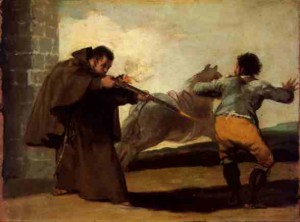 Hobsbawm, Eric J. 2000. Bandits. New York: The New Press.
Hobsbawm, Eric J. 2000. Bandits. New York: The New Press.
Hobsbawm develops his essay on “social banditry” from Primitive Rebels into a book-length exploration in this book, and in this reworked edition responds to some of the critics of the original publication (1969). As in the previous book, social bandits are a product of intransigent agrarian class relations. They operate within the bounds of a peasant moral universe, while their political aims are normally inchoate, ambiguous, malleable, and/or reformist. “Banditry simultaneously challenges the economic, social and political order by challenging those who hold or lay claim to power, law and the control of resources” (7). Bandits exist within a particular socioeconomic and political order, but they do so while acting out a living critique of that same public law and order. Banditry is “about class, wealth and power in peasant societies” (9). Hobsbawm wants to understand social banditry as a form of “social protest and rebellion” (21).
Hobsbawm defines bandits as being strongly in the eyes of the beholder: “those who are not or not only regarded as simple criminals by public opinion” (19). But authorities often paint agitators of all sorts—particularly guerrillas—as an “enemy-of-all” (14) broad-brush tactic to delegitimize their political justifications and identities.
“Social banditry of this kind is one of the most universal social phenomenon known to history, and one of the most amazingly uniform” (21). Hobsbawm outlines three recurring categories of social banditry: the noble robber à la Robin Hood, the primitive resistance fighter (a kind of proto-guerrilla), and the “terror-bringing avenger” (23). What these forms of banditry share in common is that they tend to balloon amid times of economic crisis, sometimes even being the companions or precursors to major social revolutions (27).
But they are profoundly ambiguous political actors: for instance, their penchant for preserving the “traditional order” can go “either way,” politically speaking. They can become proto-revolutionaries, as in the Balkan haiduk, or the “strong-arm rural bourgeoisie, like the Mafiosi of Sicily” (41). “Though in practice social banditry cannot always be clearly separated from other kinds of banditry, this does not affect the fundamental analysis of the social bandit as a special type of peasant protest and rebellion” (45). In this, Hobsbawm acknowledges, the political implications of banditry in general is highly variable, but his focus is on its unacknowledged radical potential (protest and rebellion).
The noble robber is perhaps the most popular—if deeply mythologized—social bandit. “His role is that of the champion, the righter of wrongs, the bringer of justice and social equity. His relation with the peasants is that of total solidarity and identity. The ‘image’ reflects both” (47). Such bandits often elicit saint-like devotion, with others coming to pray at their graves (55)—much like today’s Santa Muerte cult in Mexico—while associated stories of invulnerability become wrapped up with magic, mysticism and ritual (57). Not all is rose-tinged in popular perceptions of bandits, but even when cast as blood-drenched avengers the narratives combined cruelty and terror along with the nobility of their ends, particularly if seen through the lens of socially accepted forms of vengeance (68). But Hobsbawm also chalks up this destructive tendency as evidence of their lacking positive political program. “Their social justice was destruction” (71).
The most political (or “quasi-political movement”) of all bandits in Hobsbawm’s view are the Balkan haiduk. They were slightly more exterior to sedentary peasant communities, and they had an established tradition (or culture) of collective organization. “Unlike the ‘noble robber’, the haiduk does not depend on personal moral approval; unlike the ‘avenger’ his cruelty is not his essential characteristic, but totlerated because of his services to the people” (81). They were more permanent and institutionalized.
It is not easy to say whether this was so because of geographical or political conditions made possible such permanent and formalized banditry, and therefore automatically made it potentially more ‘political’, or whether it was certain political situations (e.g. foreign conquest or certain types of social conflict) which encouraged unusually ‘conscious’ forms of banditry and thus structured it more firmly and permanently. Both, we may say… (83)
Bandits, of course, are by definition plugged into market networks and broader economic systems. “Its needs and activities, its very existence, bring it into relations with the ordinary economic, social and political system” (91). “For the crucial fact about the bandit’s social situation is its ambiguity. He is an outsider and a rebel, a poor man who refuses to accept the normal rules of poverty, and establishes his freedom by means of the only resources within reach of the poor – strength, bravery, cunning and determination” (95).
For my purposes, the most relevant critique waged against Bandits is that presented by Anton Blok, who wrote a stellar book on the mafia in Sicily soon to be reviewed here. More common, says Blok, is for bandits to be either annihilated or co-opted by the elites and structures they at one time victimized; this is in large part due to the utter weakness of peasants. Hobsbawm himself writes: “Blok’s observation that ‘what is wrong with Hobsbawm’s perception of brigandage is that it pays too much attention to the peasants and the bandits themselves’, i.e. not enough to the larger society and its structures of power and politics, is well taken” (168).

Pingback: Sánchez and Meertens: Bandits, Peasants, Politics | Territorial Masquerades
Pingback: Geographies of the Outlaw | Territorial Masquerades